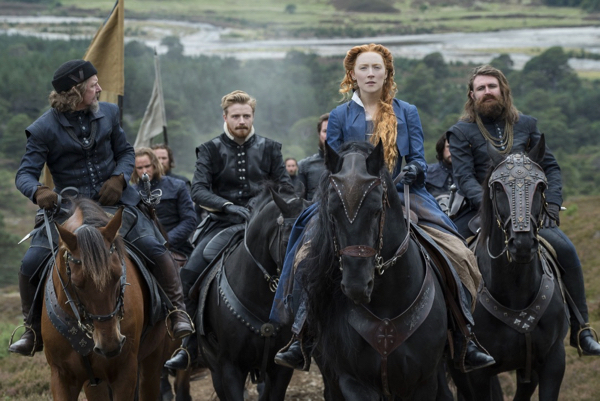Movie review by Greg Carlson
Helming her feature film debut, veteran theatre director Josie Rourke mounts a handsome but forgettable “Mary Queen of Scots” (no comma) with Saoirse Ronan and Margot Robbie. Like so many fictions rooted in the political intrigue of royalty, this latest model quickly reveals the same old preoccupation with matters of religious affiliation, sex for pleasure versus sex for the production of an heir, and marriage arranged for advantage. That narrative orientation is a bummer, since this oft-told tale becomes the very thing it aspires to criticize. Even with Ronan’s commanding presence, Robbie’s commitment to prosthetic-assisted physical transformation, and the costume and production design, Rourke’s middlebrow edition is bound for the same dusty shelf where the 1936, 1971, and 2013 versions reside.
Rourke arguably favors character over the bullet points of key dramatic events, but neither category fruits. Instead of gripping drama, the film sketches a series of decisions, usually ill-advised and often taken following the pressure of petulant narcissists like Mary’s brother, her later pair of husbands, and counselors like John Knox (David Tennant in weird beard) and William Cecil (Guy Pearce also in weird beard). The movie tries out a particularly decadent interpretation of Mary’s first cousin and second spouse Lord Darnley (Jack Lowden), as skillful a practitioner of cunnilingus as he is a brutal rapist. Lowden, wearing a well-groomed Van Dyke, registers above the other onscreen fellows until his (un)timely demise.
Period costume drama can be most entertaining when examined through the lens of contemporary concerns. In one sense, who cares whether Mary and Elizabeth didn’t really meet face to face in real life? Could Rourke have made her version of the conflict work without that scene? Dramatic license is so much a given that discussions of authenticity are as damned as they are damning. Instead, we have a Mary whose Catholicism never appears to conflict with her anachronistically progressive attitudes regarding gender fluidity, homosexuality, and religious tolerance.
Additionally, a full-length report could be written on the film’s muscular and misleading marketing campaign. The trailer suggests a kind of fantasized two-hander, but Robbie’s weirdly insecure Elizabeth factors far less, and enjoys scant screen time relative to Ronan, than what is suggested by the coming attractions preview. Long before the film was released to the public, writers of both the earnest and clickbait varieties were consulting with academics and historians regarding the inaccuracies baked into Beau Willimon’s screenplay, which is very loosely based on published work by John Guy.
Both the trailer and the posters invite a kind of expected and unsubtle compare/contrast simplification of the two women that steers away from nuance. Back in July, Nate Jones pointed out in “Vulture” that the taglines used by Focus Features in the striking character portraits — “Born to Fight” for Mary and “Born to Power” for Elizabeth — should be reversed. If one of the movie’s thematic concerns addresses the zero-sum realities of claims to the throne, that same set of disadvantages extends to the imagined “friendship” of Mary and Elizabeth. The film steers toward a reading of female leadership inside the patriarchy that says the queens, as fellow female monarchs, could have been allies instead of enemies, but Rourke never quite gets there.
